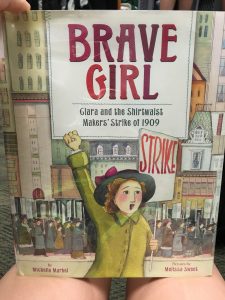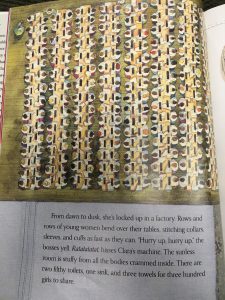Title: Brave Girl: Clara and the Shirtwaist Makers’ Strike of 1909
 Author: Michelle Markel
Author: Michelle Markel
Illustrator: Melissa Sweet
Publisher: HarperCollins Publishers, 2013
Number of pages: 32 pages
Tags: Culture, Emotion, Non-Fiction, Picture Book, 2-3, Stephanie Prentice
Genre: Biography
Analysis
Clara Lemlich was an immigrant that came to America in hopes of a better life. She was unaware that immigrant women were hired into garment workshops to make blouses and other articles of clothing. After realizing that the conditions in which she and millions of other women worked, she lead many revolts and strikes to change the conditions of their work.
This children’s book allows students to see the struggles of the immigrants in the 1900’s first hand, especially those of women. The culture of America is represented in this story, focusing on the industrial movement during this time period. Students are able to grasp the values of the United States through the pictures as well as the text. Readers can see the value of mass production in the illustrator’s depiction of the workshops. The distribution of power in this story shifts from the owners of the garment shops to those who work are employed in these shops. Before Clara leads the revolts, the garment shop owners are in complete control of the conditions and hours the immigrant women were to work. After the story, we see the power shift to the immigrant workers as they battled for their rights.
Looking at the pictures closely, students can get a feel for the conditions many immigrants faced. Fo r example, when Clara arrives in America on the boat, the illustrator included an image of the long line of people waiting on the boat for their new life in America. The text is displayed on a stitched piece of fabric that connects to the main theme of the story very well. The pictures are often sewn into the text, making them resemble a quilt. Clara is often found looking or moving to the right of the page, signifying the change that is going to happen. The author uses many adjectives that emphasize the struggles Clara and her colleagues faced. For example, when Clara first arrives, the author introduces her as dirt poor and five feet tall. Ideologically, this story has many things that children can take away after reading. First and foremost, this book gives the students a historical look into the life of immigrants, especially those of women. This book focuses on the hardships and challenges that Clara faced with work and learning to speak English. Secondly, it shows students how important it is to stand up for what they know is right. If Clara were not to stand up for what she believed was right, many workers would have suffered for a longer period of time. Even after Clara faced many arrests, beatings, and threats to be fired, she kept the fight for her rights alive. It proves that determination and perseverance can lead to change for what is right. At the end of the book, readers are introduced to more information about the garment industry that can further their understanding on the topic.
r example, when Clara arrives in America on the boat, the illustrator included an image of the long line of people waiting on the boat for their new life in America. The text is displayed on a stitched piece of fabric that connects to the main theme of the story very well. The pictures are often sewn into the text, making them resemble a quilt. Clara is often found looking or moving to the right of the page, signifying the change that is going to happen. The author uses many adjectives that emphasize the struggles Clara and her colleagues faced. For example, when Clara first arrives, the author introduces her as dirt poor and five feet tall. Ideologically, this story has many things that children can take away after reading. First and foremost, this book gives the students a historical look into the life of immigrants, especially those of women. This book focuses on the hardships and challenges that Clara faced with work and learning to speak English. Secondly, it shows students how important it is to stand up for what they know is right. If Clara were not to stand up for what she believed was right, many workers would have suffered for a longer period of time. Even after Clara faced many arrests, beatings, and threats to be fired, she kept the fight for her rights alive. It proves that determination and perseverance can lead to change for what is right. At the end of the book, readers are introduced to more information about the garment industry that can further their understanding on the topic.
